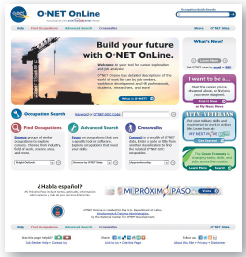Tech Tip: Conducting Industry Research
TECH TIP CONDUCTING INDUSTRY RESEARCH
TECH TIP CONDUCTING INDUSTRY RESEARCH

In the world of business, anything older than six months is considered ancient history. Today, finding information about industries, companies, and associated workforce characteristics is a requisite stop if you want to get a sense of occupational trends, the coolest sectors, the most in-demand college majors, where the money is, and who’s hiring.
1 THE PROBLEM
You have no idea where to begin your industry research.
2 THE FIX
Start with tried-and-true comprehensive resources: O*Net, the Occupational Outlook Handbook, and a targeted hunt.
3 HOW TO DO IT
Visit onetonline.org to do the following:
Find occupations to explore.
Search for occupations that use your skills.
Look at related occupations.
View Summary and Detail Reports, including the most important characteristics of the worker and work requirements.
Connect to other online career information resources.
4 TIPS FOR GETTING STARTED
Visit onetonline.org and use the find occupations option at top of page to begin your search.
Search occupations by keyword, choose from occupational categories, or search specialty industries.
Career Clusters are occupations in the same field of work that require similar skills.
Industry represents broad groups of businesses or organizations with similar activities, products, or services.
Job Zones group occupations into one of five categories based on levels of education, experience, and training necessary to perform the occupation.
Bright Outlook lists occupations that are expected to grow rapidly in the next several years.
Job Families are groups of occupations based on work performed, skills, education, training, and credentials.
STEM occupations require education in science, technology, engineering, or mathematics (STEM).
Green Economy lists green occupations linked to Green Economy Sectors.
The search results for your particular occupation are listed in a rank order calculated on relevance of the occupational title, alternate titles, description, tasks, and detailed work activities associated with the keyword you entered.
Select the Relevance Score to view the specific items matched by your search within the occupation.
Review the Occupational Report associated with each desired occupation to find the following information related to each occupation:
Tasks | Tools & Technology | Knowledge | Skills | Abilities | Work Activities | Work Context | Job Zone |Education | Interests | Work Styles | Work Values | Related Occupations | Wages & Employment |Additional Information
Use this Summary Report to make informed decisions about your professional choices, both academic and career-related.
SOME THINGS YOU SHOULD EXPLORE
How much does your chosen major figure into your career goals? That is a good question. Some jobs have fixed requirements if your goal is to become a nurse, you probably shouldn’t be a dance major. Likewise, if you’ve never taken biology courses, you probably won’t get into medical school. Most other majors offer plenty of flexibility.
Do you have to major in business to make money? No. Students who major in the humanities learn valuable critical-thinking skills that can help them succeed as lawyers, editors, or gallery owners. A women’s studies or creative writing major might nab a job in account management, marketing, or public relations. Try to study what you like and figure out a way to make it work for your future. In the end, it’s all about how you market yourself.
PERSONAL BEST
Using the Find Occupations bar of onetonline.org, search three occupations you’re interested in pursuing after you finish college. List the required knowledge and skills, education, and experience needed to qualify for those jobs upon graduation.
ONE STEP FURTHER
Create an Online Profile on LinkedIn.com. Your online profile should be professional. Include your résumé and the information you’d like potential employers to know.
Source: O*NET OnLine, www.onetonline.org; Occupational Outlook Handbook, www.bls.gov/ooh.